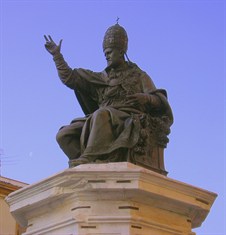Paul V
 Camillo Borghese (1552-1621) was elected pope, under the name of Paul V, on 16 May 1605. Born in Rome, he was a member of a family originally from Siena. A legal scholar, he was elected cardinal in 1596 by Pope Clement VIII, for whom he also served as a diplomat at the Spanish court of Philip II. Shortly after his election, he clashed with the Republic of Venice, against which he proclaimed an Interdict, resulting in a serious international crisis. He did not reject the nepotistic practices of the popes, ensuring social and economic ascent to his family and in particular to the cardinal-nephew Scipione Borghese. Under Paul V the heliocentric theories of Galileo Galilei were judged and condemned, some of the the leading figures of Catholicism in those years such as Charles Borromeo Ignatius of Loyola, Teresa of Avila and Filippo Neri were beatified. Among the changes he brought to the town layout of Rome, were the radical change in the design of Michelangelo’s Saint Peter’s Basilica, the plan of which was modified with addition, in the tympanum, of the giant inscription: “PAULUS V BURGHESIUS ROMANUS”.
Camillo Borghese (1552-1621) was elected pope, under the name of Paul V, on 16 May 1605. Born in Rome, he was a member of a family originally from Siena. A legal scholar, he was elected cardinal in 1596 by Pope Clement VIII, for whom he also served as a diplomat at the Spanish court of Philip II. Shortly after his election, he clashed with the Republic of Venice, against which he proclaimed an Interdict, resulting in a serious international crisis. He did not reject the nepotistic practices of the popes, ensuring social and economic ascent to his family and in particular to the cardinal-nephew Scipione Borghese. Under Paul V the heliocentric theories of Galileo Galilei were judged and condemned, some of the the leading figures of Catholicism in those years such as Charles Borromeo Ignatius of Loyola, Teresa of Avila and Filippo Neri were beatified. Among the changes he brought to the town layout of Rome, were the radical change in the design of Michelangelo’s Saint Peter’s Basilica, the plan of which was modified with addition, in the tympanum, of the giant inscription: “PAULUS V BURGHESIUS ROMANUS”.
